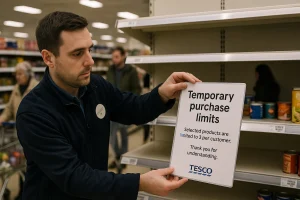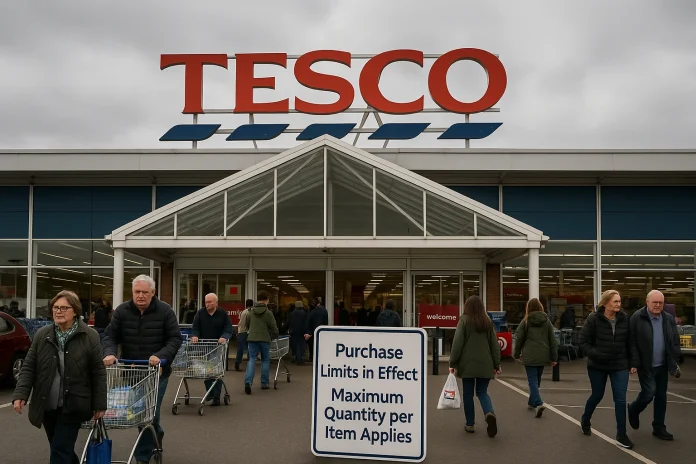Table of Contents
Tesco, the UK’s largest supermarket chain, has introduced new purchase quantity limits across its stores to manage stock availability and ensure fair access to essential items.
With over 2,900 locations nationwide, millions of shoppers rely on Tesco for their weekly groceries.
These limits, now applied to a variety of everyday products, aim to prevent bulk buying and reduce pressure on supply chains.
The updated rules reflect Tesco’s ongoing efforts to balance customer demand with operational efficiency across the country.
Why Has Tesco Introduced Purchase Quantity Limits?

Tesco has introduced purchase quantity limits in response to rising concerns around stock availability and customer fairness.
These measures aim to tackle excessive purchasing behaviours that can lead to product shortages, especially during times of heightened demand.
The UK’s retail sector has faced several ongoing challenges including supply chain disruptions, unpredictable consumer purchasing patterns and economic uncertainty.
Tesco, being the UK’s leading supermarket chain with over 2,900 outlets, has opted to implement quantity limits as a preventative strategy rather than reacting to supply shortages after they occur.
These limits are also influenced by seasonal factors. During the winter and holiday periods, the demand for essential food products significantly increases.
Tesco’s decision to restrict quantities of specific items is driven by the need to ensure shelves remain stocked for all customers, not just those who can afford to buy in bulk or shop earlier.
What Are the Current Item Limits Tesco Has Set?
Tesco’s current restriction policy applies to a range of everyday grocery items. While the maximum allowable quantity may vary slightly depending on product and store, many items are currently limited to a maximum of 16 units per transaction.
This policy covers fresh produce, dairy, meats, bakery products and beverages. The idea is to maintain fair access for all customers across its national store network.
The following table lists examples of some Tesco products affected by the quantity limits:
| Product | Limit Per Customer |
| Tesco Wafer Thin Honey Roast Ham Slices 125g | 16 units |
| Tesco Beef Mince 20% Fat 500g | 16 units |
| Tesco Parmigiano Reggiano Cheese 200g | 16 units |
| Tesco White Toastie Bread Thick Sliced 800g | 16 units |
| Tesco British Semi Skimmed Milk 2.272L | 16 units |
| Tesco Greek Style Natural Yogurt 1Kg | 16 units |
| Tesco 100% Pure Orange Juice Smooth 1 Litre | 16 units |
| Tesco Chicken Mince 5% Fat 500G | 16 units |
| Nightingale Farms Peppers 375G | 16 units |
| Tesco Whole Cucumber | 16 units |
This limit applies regardless of whether the purchase is made in-store or online. The system automatically restricts adding more than the allowed number to the customer’s basket.
Staff members are also advised to notify shoppers of the policy if large quantities are attempted at self-checkout kiosks.
How Do Tesco’s Purchase Limits Affect Shoppers?

Tesco’s decision to introduce purchase quantity limits is having a noticeable effect on various types of customers, from large families to community organisers. Although the restrictions are designed to improve stock availability, not all shoppers experience the policy in the same way.
Impact on Larger Households and Weekly Shoppers
For families who do a single large shop every week, the new limits can be inconvenient. Items such as milk, bread and fresh meat are staple products that households often buy in bulk.
With limits set at 16 units per item, shoppers may need to visit Tesco multiple times throughout the week or turn to other stores to fulfil their full grocery needs.
This can increase both time spent shopping and travel costs, especially for those in rural areas where Tesco is the only major supermarket nearby.
Challenges for Bulk and Community Buyers
Community groups, food banks, and small hospitality businesses often rely on Tesco for cost-effective bulk purchases.
Under the new rules, they may struggle to acquire the quantities they need in a single visit. Even when buying online, these customers will face limitations that require them to split orders or find alternative suppliers.
Although Tesco does not currently offer exemptions for these types of buyers, affected individuals can reach out to store managers or customer service to discuss possible solutions.
Differences Between In-Store and Online Purchases
While the same purchase limits generally apply both in-store and online, the experience of managing them can differ.
In-store, customers may be unaware of the restrictions until checkout, which could result in delays or having to remove items from their trolley.
Online, the system automatically blocks any attempt to exceed the cap by displaying a notification, preventing users from proceeding with the order.
Although this is more transparent, it may still frustrate those trying to shop efficiently for larger groups or households.
What Is Tesco’s Official Statement on These Limits?
Tesco has not released a full press announcement regarding the limits but has offered a consistent explanation across its platforms.
The company states: “To ensure availability of all our products, customers may be limited to a maximum number of items.”
This notice appears on Tesco’s website next to the affected product listings and in select stores across the UK.
While the limit per item is currently set at 16 for many products, Tesco has the flexibility to adjust the quantity based on real-time demand and product availability.
The company has positioned this move as part of a broader strategy to manage store inventory efficiently.
It is especially relevant during high-demand periods like the pre-Christmas season, when stock control is essential.
How Does the New ‘Weigh Bridge’ System Work?
Tesco has also started trialling a new technology-based system to monitor customer purchases at self-service points.
This system focuses on customers using the Scan as You Shop feature, allowing them to scan items individually while shopping and avoid long queues at checkout.
To prevent theft or accidental under-scanning, the retailer has introduced push-on scales or trolley weigh bridges. Here’s how the system functions:
- Customers scan items using handheld devices as they shop.
- At checkout, the trolley is placed on a scale.
- The system cross-checks the total scanned weight against the actual weight.
- If the numbers align, the customer proceeds to payment.
- If there is a mismatch, a Tesco employee is notified to manually verify the contents.
The goal is to discourage theft and encourage scanning accuracy without overtly inconveniencing genuine customers. This technology is currently limited to a small number of stores as part of a trial phase.
Are Customers Reacting Positively or Negatively?

The introduction of both quantity limits and the weigh bridge system has generated mixed reactions from customers.
Some shoppers understand the reasoning behind the changes, especially in the context of preventing stockpiling and theft. However, others have taken to social media platforms to voice their frustration.
A portion of customers believe that these systems reflect a lack of trust. They argue that genuine shoppers are being unfairly treated or inconvenienced due to the actions of a few.
Examples of public sentiment include:
- Frustration about being monitored and weighed at checkout
- Complaints about the inability to buy in bulk for large households
- Concerns about Tesco replacing staff with automated systems
One common theme in the criticism is that shoppers feel penalised despite being loyal and honest customers. Some have even threatened to switch supermarkets if these systems become widespread.
How Do Tesco’s Policies Compare to Other UK Supermarkets?
Tesco is not alone in implementing such policies. Several other UK supermarket chains have also resorted to similar purchase limits during times of high demand.
However, Tesco stands out for combining product caps with advanced anti-theft technology.
Below is a comparison of Tesco’s policies with some of its main competitors:
| Supermarket | Purchase Limits | Security Measures for Self-Scan |
| Tesco | Yes, commonly 16 items | Weigh bridge system on trolleys |
| Sainsbury’s | Occasionally enforced | Random rescans at exit points |
| ASDA | Limited during shortages | Manual staff checks at self-checkout |
| Aldi | Frequent limits during sales | No advanced scanning system |
| Lidl | Rare, product-specific | Manual monitoring by staff |
While Tesco’s technology may improve inventory accuracy and reduce losses, its effectiveness will depend on shopper acceptance and how the trial develops into long-term store policy.
What Should Shoppers Do If They’re Affected?
Tesco’s policies are likely to remain in place during high-demand periods, meaning affected customers must adapt their shopping habits.
While the restrictions are not overly strict, they require a bit of planning and flexibility from those who are used to bulk buying.
Adjusting Shopping Frequency and Timing
Shoppers may benefit from spacing out their grocery trips rather than relying on one weekly visit.
By planning two smaller shops instead of one large one, it becomes easier to stay within the limit without compromising on quantity.
Shopping during off-peak hours may also help avoid long queues or stock shortages caused by high footfall.
Exploring Other Retail Options
Customers can consider diversifying where they shop. For example, purchasing some of their usual Tesco products from nearby Sainsbury’s, Morrisons, or local independent stores could allow them to bypass some of the limitations.
Additionally, visiting local markets for fresh produce may reduce dependency on supermarket chains entirely.
Coordinating with Household Members
In situations where a single person usually does the family shop, dividing the task among multiple household members can help manage the limits.
If two people shop separately, they can legally purchase more within the rules. However, this should be done responsibly to ensure the intent of the policy fair distribution is respected.
Contacting Tesco for Special Circumstances
Shoppers purchasing on behalf of charities, schools or vulnerable individuals should consider contacting Tesco’s customer service or local store management. While the general rule is applied uniformly, there may be allowances or advice for those with a legitimate need to exceed the cap.
By planning ahead and using available resources, most customers can adapt to Tesco’s new purchase quantity limits without significant disruption to their routine.
Will These Restrictions Be Permanent?

Tesco has not given a definitive timeline for how long these quantity limits will remain in place. Current indications suggest the policies are temporary and likely to fluctuate based on the following factors:
- National and regional stock levels
- Seasonal demand patterns
- Consumer behaviour during peak times
- Global supply chain stability
Retail analysts suggest that such restrictions are most commonly introduced before major holidays, during periods of inflation, or when specific products face import or production delays. If these conditions stabilise, the restrictions could be lifted or eased gradually.
Tesco continues to monitor customer feedback and operational efficiency as part of its ongoing review of store policies. Future decisions on limits or checkout procedures will likely reflect this combination of shopper experience, stock availability, and retail technology advancements.
Conclusion
Tesco’s new purchase quantity limits and anti-theft systems reflect a broader trend in UK retail towards tightening control over inventory and customer behaviour.
While the intention behind the rules is to ensure fairness and reduce losses, some shoppers see them as a breach of trust or an unnecessary hurdle in their weekly shop.
Whether these changes remain temporary or become long-term policies will depend on both customer feedback and broader economic conditions.
For now, shoppers are advised to stay informed and adjust accordingly to make the most of their Tesco visits.
FAQs about Tesco Purchase Quantity Limits
Are there different limits for online orders?
Yes. Tesco applies similar quantity caps online, but you may encounter different restrictions depending on regional stock availability and delivery schedules.
Why are only certain Tesco items restricted?
Tesco targets high-demand, essential products for limits to prevent stockpiling and ensure availability for all customers.
Do Clubcard users get exemption from limits?
No. Purchase quantity limits apply equally to Clubcard and non-Clubcard users.
Can I go back in and buy the same item again?
While technically possible, repeated purchases of the same restricted item in one day may be flagged, especially during high-alert periods.
Is Tesco the only supermarket doing this?
No. Other supermarkets like Aldi and Sainsbury’s also implement purchase limits during times of shortage or high demand.
What happens if I exceed the limit at self-checkout?
The system will prevent you from scanning or purchasing more than the allowed quantity, and a staff member may intervene.
Will Tesco increase limits before holidays?
This depends on stock levels and customer demand. Restrictions may tighten or relax based on trends leading up to holidays like Christmas.


